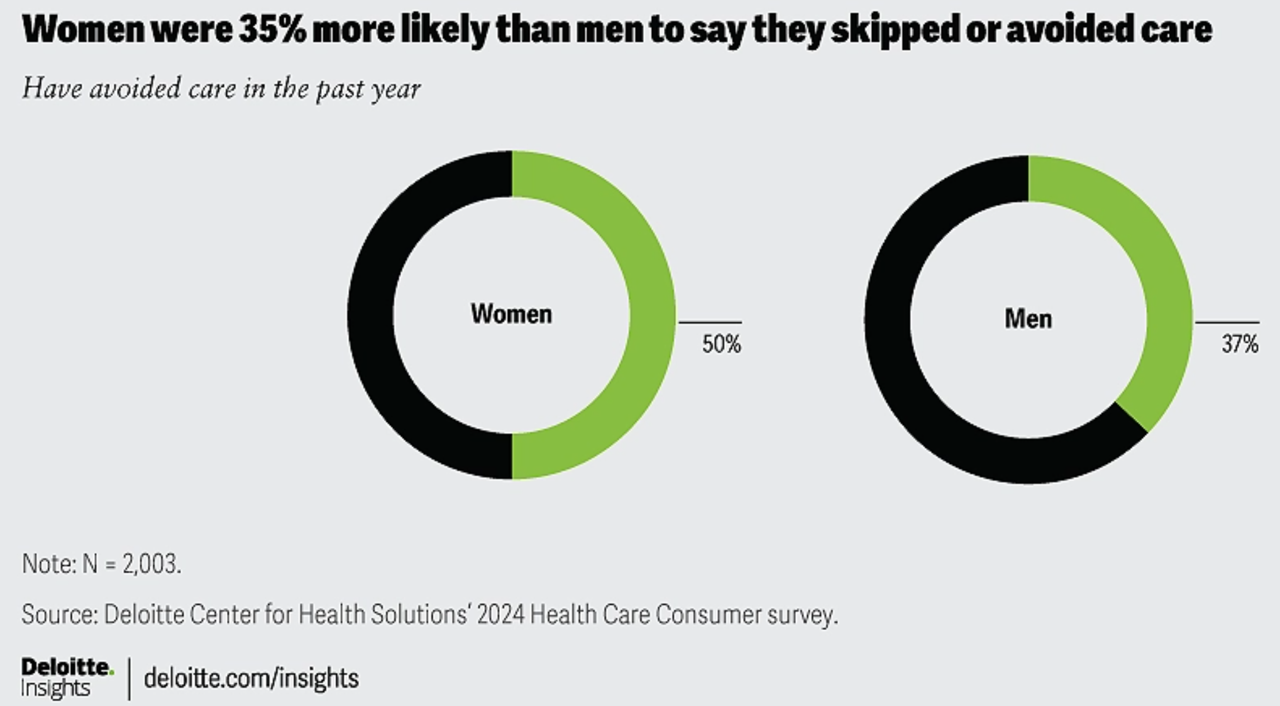Women in the U.S. are more likely to avoid care than men in America, Deloitte found in the consulting firm’s latest survey on consumers and health care.

Deloitte coins this phenomenon as a “triple-threat” that women face in the U.S. health care environment, the 3 “threats” being,
- Affordability,
- Access, and,
- Prior experience — that is the health disparity among women who have seen personal mis-diagnosis, bias, or treatment that hasn’t been consistent with current protocols and practices.
The data come out of Deloitte’s fielding of the U.S. consumer survey in February and March, 2024.

Here are the many reasons a woman living in America has for skipping or delaying health care, Deloitte illustrated in Figure 3 from the report.
First, the long-time driver of self-rationing care in the U.S., is costs — in this study, that out-of-pocket costs were seen as too high for the 21% of women skipping care, compared with 16% of men who did so.
Second, too-long waiting times for appointments to visit the doctor motivate 15% of women to skip care, versus 10% of men in the U.S.
Third, both “not feeling well enough to visit the doctor” as well as lack of transportation to get to the appointment drove 9% of women to not seek care.

Health Populi’s Hot Points: In a previous report, Deloitte asserted in the title that, “The future of health is female,” exploring the impact of women and health in society.
As “the bedrock” of that society, Deloitte said that women,
- Are America’s most powerful consumers,
- Play an indispensable role in the workforce, and,
- Improving women’s health improves overall population health.
You can read more details for each of these impacts from the page clipped from Deloitte’s report in the graphic here.
As Deloitte Consulting’s Chief Health Equity Officer (and Managing Principal) Dr. Kulleni Gebreves called out,
“These findings are a stark reminder of how women’s health and wealth are inextricably intertwined. By dismantling the barriers women have identified, together we can create a future where women don’t have to make the difficult choice between maintaining their health or maintaining their financial wellbeing.”
As you filter these findings through your own business operations, plans, and innovations, consider how to address supporting the Bedrock of Society, women and their health, through your work and in your personal lives: this could involve,
- Thinking omni-channel, meeting women where they “are,” in person, at home, closer-to-home, and via virtual networks leveraging telehealth, texting, and other remote technologies;
- Bolstering clinicians’ understanding of and resources supporting women’s and children’s health issues, assuring doctors, nurses, and allied health professionals’ education is continually refreshed to update providers with current protocols, evidence, and tools to bridge disparities and improve women’s access to contemporary care — for example, for heart care and disease which has significant disparities among women compared with men; and,
- Voting in elections to assure women’s health and related policies that lower the risks of health disparities and inequities.

For more on women and health policy in the 2024 election cycle, you can explore the Open Letter on the site of Women Healthcare Leaders for Progress, of which I am one of several hundred signing the Letter.




 I love sharing perspectives on what's shaping the future of health care, and appreciate the opportunity to be collaborating once again with Duke Corporate Education and a global client on 6th May. We'll be addressing some key pillars to consider in scenario planning such as growing consumerism in health care, technology (from AI to telehealth), climate change, and trust -- the key enabler for health engagement or dis-engagement and mis-information. I'm grateful to be affiliated with the corporate education provider
I love sharing perspectives on what's shaping the future of health care, and appreciate the opportunity to be collaborating once again with Duke Corporate Education and a global client on 6th May. We'll be addressing some key pillars to consider in scenario planning such as growing consumerism in health care, technology (from AI to telehealth), climate change, and trust -- the key enabler for health engagement or dis-engagement and mis-information. I'm grateful to be affiliated with the corporate education provider  Thank you FeedSpot for
Thank you FeedSpot for